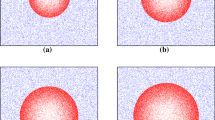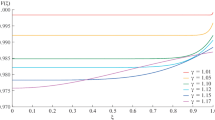Abstract
The solution for the radial distribution of pressure, density, temperature and flow velocity fields in a blast wave propagating through a medium at rest, following an intense explosion, starting from hydrodynamic equations, is one of the classic problems in gas dynamics. However, there is very little direct verification of the theory and its assumptions from simulations of microscopic models. In this paper, we compare the results and assumptions of the hydrodynamic theory with results from large scale event driven molecular dynamics simulations of a hard sphere gas in three dimensions. We find that the predictions for the radial distribution of the thermodynamic quantities do not match well with the numerical data. We improve the theory by replacing the ideal gas law with a more realistic virial equation of state for the hard sphere gas. While this improves the theoretical predictions, we show that they still fail to describe the data well. To understand the reasons for this discrepancy, the different assumptions of the hydrodynamic theory are tested within the simulations. A key assumption of the theory is the existence of a local equation of state. We validate this assumption by showing that the local pressure, temperature and density obey the equation of state for a hard sphere gas. However, the probability distribution of the velocity fluctuations has non-gaussian tails, especially away from the shock front, showing that the assumption of local equilibrium is violated. This, along with neglect of heat conduction, could be the possible reasons for the mismatch between theory and simulations.











Similar content being viewed by others
References
Abdel-Raouf, A., Gretler, W.: Quasi-similar solutions for blast waves with internal heat transfer effects. Fluid Dyn. Res. 8, 273–285 (1991)
Anand, R.: Shock dynamics of strong imploding cylindrical and spherical waves with non-ideal gas effects. Wave Motion 50, 1003–1015 (2013)
Antal, T., Krapivsky, P.L., Redner, S.: Exciting hard spheres. Phys. Rev. E 78, 030301 (2008). https://doi.org/10.1103/PhysRevE.78.030301
Barbier, M., Villamaina, D., Trizac, E.: Blast dynamics in a dissipative gas. Phys. Rev. Lett. 115, 214301 (2015). https://doi.org/10.1103/PhysRevLett.115.214301
Barbier, M., Villamaina, D., Trizac, E.: Microscopic origin of self-similarity in granular blast waves. Phys. Fluids 28, 083302 (2016). https://doi.org/10.1063/1.4961047
Barenblatt, G.: Scaling, Self-similarity, and Intermediate Asymptotics: Dimensional Analysis and Intermediate Asymptotics. Cambridge University Press, Cambridge (1987)
Berezinsky, V., Dokuchaev, V.: Hidden source of high-energy neutrinos in collapsing galactic nucleus. Astropart. Phys. 15, 87–96 (2001)
Boudet, J.F., Cassagne, J., Kellay, H.: Blast shocks in quasi-two-dimensional supersonic granular flows. Phys. Rev. Lett. 103, 224501 (2009). https://doi.org/10.1103/PhysRevLett.103.224501
Brode, H.L.: Numerical solutions of spherical blast waves. J. Appl. Phys. 26, 766 (1955). https://doi.org/10.1063/1.1722085
Castor, J., McCray, R., Weaver, R.: Interstellar bubbles. Astrophys. J. 200, L107–L110 (1975)
Cheng, X., Xu, L., Patterson, A., Jaeger, H.M., Nagel, S.R.: Towards the zero-surface-tension limit in granular fingering instability. Nat. Phys. 4, 234 (2008)
Cioffi, D.F., Mckee, C.F., Bertschinger, E.: Dynamics of radiative supernova remnants. Astrophys. J. 334, 252–265 (1988)
Dokuchaev, V.I.: Self-similar shock solution with sustained energy injection. Astronomy Astrophys. 395, 1023–1029 (2002). https://doi.org/10.1051/0004-6361:20021305
Edens, A., Ditmire, T., Hansen, J., Edwards, M., Adams, R., Rambo, P., Ruggles, L., Smith, I., Porter, J.: Study of high mach number laser driven blast waves. Phys. Plasmas 11, 4968–4972 (2004). https://doi.org/10.1063/1.1773553
Edwards, M.J., MacKinnon, A.J., Zweiback, J., Shigemori, K., Ryutov, D., Rubenchik, A.M., Keilty, K.A., Liang, E., Remington, B.A., Ditmire, T.: Investigation of ultrafast laser-driven radiative blast waves. Phys. Rev. Lett. 87, 085004 (2001). https://doi.org/10.1103/PhysRevLett.87.085004
Falle, S.: A numerical calculation of the effect of stellar winds on the interstellar medium. Astonomy Astrophys. 43, 323–336 (1975)
Ghoniem, A., Kamel, M., Berger, S., Oppenheim, A.: Effect of internal heat transfer on the structure of self-similar blast waves. J. Fluid Mech. 117, 473–491 (1982). https://doi.org/10.1017/S0022112082001724
Grasselli, Y., Herrmann, H.J.: Crater formation on a three dimensional granular heap. Granul. Matter 3(4), 201–204 (2001). https://doi.org/10.1007/s100350100095
Guderley, G.: Powerful spherical and cylindrical compression shocks in the neighbourhood of the centre and of the cylinder axis. Lufifahrtforschung 19, 302–312 (1942)
Gull, S.: A numerical model of the structure and evolution of young supernova remnants. Monthly Not. R. Astronomical Soc. 161, 47–69 (1973)
Hirschler, T., Steiner, H.: A self-similar solution for the implosion problem in a dusty gas. Fluid Dyn. Res. 32, 61–67 (2003)
Huang, H., Zhang, F., Callahan, P.: Granular fingering in fluid injection into dense granular media in a hele-shaw cell. Phys. Rev. Lett. 108, 258001 (2012). https://doi.org/10.1103/PhysRevLett.108.258001
Isobe, M.: Hard sphere simulation in statistical physics—methodologies and applications. Mol. Simul. 42, 1317–1329 (2016). https://doi.org/10.1080/08927022.2016.1139106
Jabeen, Z., Rajesh, R., Ray, P.: Universal scaling dynamics in a perturbed granular gas. Eur. Phys. Lett. 89(3), 34001 (2010)
Johnsen, O., Toussaint, R., Måløy, K.J., Flekkøy, E.G.: Pattern formation during air injection into granular materials confined in a circular hele-shaw cell. Phys. Rev. E 74, 011301 (2006). https://doi.org/10.1103/PhysRevE.74.011301
Joy, J.P., Pathak, S.N., Das, D., Rajesh, R.: Shock propagation in locally driven granular systems. Phys. Rev. E 96, 032908 (2017). https://doi.org/10.1103/PhysRevE.96.032908
Landau, L., Lifshitz, E.: Course of Theoretical Physics—Fluid Mechanics. Butterwörth-Heinemann, Oxford (1987)
Latter, R.: Similarity solution for spherical shock wave. J. Appl. Phys. 26, 954 (1955). https://doi.org/10.1063/1.1722144
Lazarus, R.B.: Self-similar solutions for converging shocks and collapsing cavities. SIAM J. Numer. Anal. 18, 316–371 (1981)
McCoy, B.M.: Advanced Statistical Mechanics. Oxford Science Publications, Oxford (2009)
Metzger, P.T., Schuler, R.C.L., Immer, J.M.: Craters formed in granular beds by impinging jets of gas. AIP Conf. Proc. 1145, 767–770 (2009). https://doi.org/10.1063/1.3180041
Moore, A.S., Symes, D.R., Smith, R.A.: Tailored blast wave formation: developing experiments pertinent to laboratory astrophysics. Phys. Plasmas 12, 052707-1–052707-7 (2005). https://doi.org/10.1063/1.1909199
Ostriker, J.P., McKee, C.F.: Astrophysical blastwaves. Rev. Mod. Phys. 60, 1–68 (1988). https://doi.org/10.1103/RevModPhys.60.1
Pathak, S.N., Jabeen, Z., Ray, P., Rajesh, R.: Shock propagation in granular flow subjected to an external impact. Phys. Rev. E 85, 061301 (2012). https://doi.org/10.1103/PhysRevE.85.061301
Pinto, S.F., Couto, M.S., Atman, A.P.F., Alves, S.G., Bernardes, A.T., de Resende, H.F.V., Souza, E.C.: Granular fingers on jammed systems: new fluidlike patterns arising in grain-grain invasion experiments. Phys. Rev. Lett. 99, 068001 (2007). https://doi.org/10.1103/PhysRevLett.99.068001
Plooster, M.N.: Shock waves from line sources: numerical solutions and experimental measurements. Phys. Fluids 13, 2665 (1970). https://doi.org/10.1063/1.1692848
Ponchaut, N.F., Hornung, H., Pullin, D., Mouton, C.: On imploding cylindrical and spherical shock waves in a perfect gas. J. Fluid Mech. 560, 103–122 (2006)
Rapaport, D.C.: The Art of Molecular Dynamics Simulations. Cambridge University Press, Cambridge (2004)
Sandnes, B., Knudsen, H.A., Måløy, K.J., Flekkøy, E.G.: Labyrinth patterns in confined granular-fluid systems. Phys. Rev. Lett. 99, 038001 (2007). https://doi.org/10.1103/PhysRevLett.99.038001
Sedov, L.: Propagation of strong shock waves. J. Appl. Math. Mech. 10, 241–250 (1946)
Sedov, L.: Similarity and Dimensional Methods in Mechanics, 10th edn. CRC Press, Florida (1993)
Steiner, H., Gretler, W.: The propagation of spherical and cylindrical shock waves in real gases. Phys. Fluids 6, 2154 (1994). https://doi.org/10.1063/1.868218
Taylor, G.: The formation of a blast wave by a very intense explosion. I. Theoretical discussion. Proc. R. Soc. Lond. Ser. A 201(1065), 159–174 (1950)
Taylor, G.: The formation of a blast wave by a very intense explosion. II. The atomic explosion of 1945. Proc. R. Soc. Lond. A 201(1065), 175–186 (1950)
von Neumann, J.. : In: Collected Works. Pergamon Press, Oxford, p. 219 (1963)
VonNeumann, J., Richtmyer, R.: A method for the numerical calculation of hydrodynamic shocks. J. Appl. Phys. 21, 232 (1950). https://doi.org/10.1063/1.1699639
Walsh, A.M., Holloway, K.E., Habdas, P., de Bruyn, J.R.: Morphology and scaling of impact craters in granular media. Phys. Rev. Lett. 91, 104301 (2003). https://doi.org/10.1103/PhysRevLett.91.104301
Weaver, R., McCray, R., Castor, J.: Interstellar bubbles. II. Structure and evolution. Astrophysica J. 218, 377–395 (1977)
Whitham, G.: Linear and Nonlinear Waves. Wiley, New York (1974)
Woltjer, L.: Supernova remnants. Ann. Rev. Astron. Astrophys. 10(1), 129–158 (1972). https://doi.org/10.1146/annurev.aa.10.090172.001021
Zel’dovich, Y.B., Raizer, Y.P.: Physics of Shock Waves and High Temperature Hydrodynamic Phenomena. Dover Publications Inc, New York (2002)
Acknowledgements
The simulations were carried out on the supercomputer Nandadevi at The Institute of Mathematical Sciences.
Author information
Authors and Affiliations
Corresponding author
Additional information
Communicated by Deepak Dhar.
Publisher's Note
Springer Nature remains neutral with regard to jurisdictional claims in published maps and institutional affiliations.
Rights and permissions
About this article
Cite this article
Joy, J.P., Pathak, S.N. & Rajesh, R. Shock Propagation Following an Intense Explosion: Comparison Between Hydrodynamics and Simulations. J Stat Phys 182, 34 (2021). https://doi.org/10.1007/s10955-021-02715-3
Received:
Accepted:
Published:
DOI: https://doi.org/10.1007/s10955-021-02715-3




